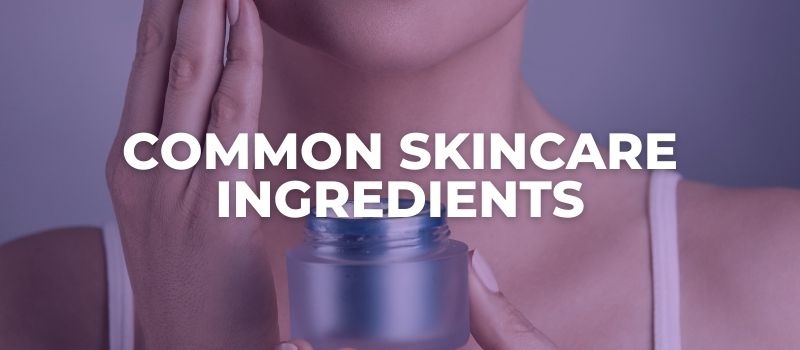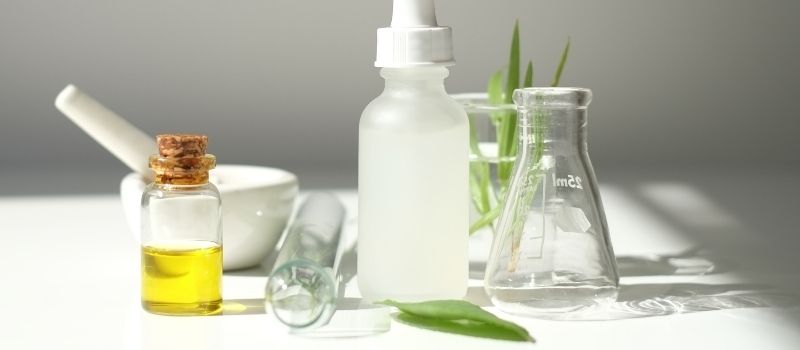All of us want to use good skincare products that are going to complement and improve our skin.
However, knowing which ingredients to avoid in skincare products can be challenging, especially if you don’t have the time to do your research.
If you are just a regular person who wants to take good care of their skin and mind their business, spending hours researching skincare ingredients to avoid probably isn’t your idea of having a great time.
This is why today, I want to give you a quick overview of the most common ingredients found in skincare, what they do, how they work, and what they are for.
If that’s what you’re looking for, keep reading…

Understanding The Ingredients List
The first thing you need to look at isn’t the claim on the packaging, it’s the ingredients list.
Understanding ingredient lists isn’t something that everyone is interested in and this is probably the most boring part when choosing skincare products.
I mean, how are you even supposed to know which ingredients are good for you, which aren’t, and what about those long and technical names that nobody can pronounce?
Alright, no pressure. Things really don’t have to be that complicated. Here’s what you should know:
Every single cosmetic product has its full ingredients listed on the packaging. Once you’ve located the list, the next thing is to find out what the ingredients are.
Some ingredients like water, glycerin, or aloe vera are easy enough to understand.
But what about magnesium ascorbyl phosphate or Cetearyl glucoside?
How do you even pronounce that?
Well, you can go on INCIdecoder and search them up if you are interested; however, this can still be a time-consuming option you really don’t wanna do. What you do want to do is learn how to recognize how the listed ingredients will affect your skin…
The (Most Common) Ingredients Found In Skincare

Active and Inactive Ingredients
In most beauty products, ingredients are listed according to their concentration in that particular product.
You should know that ingredients present in the highest concentrations top the list, and so on.
Then there is a group of cosmetics considered “over-the-counter drugs” such as physical sunscreens and products intended to treat acne, whose ingredients are listed as active and inactive.
An active ingredient is one approved by the FDA to perform a specific function for a given specific condition. For example, zinc oxide and titanium dioxide serve as sun protection.
Benzoyl peroxide is an active ingredient in over-the-counter acne products. Retinol (vitamin A) is an anti-aging powerhouse that helps treat anything from fine lines, wrinkles, and hyperpigmentation.
On the other hand, you have the inactive ingredients, which aren’t really inactive as they are efficient in providing support for the active ingredients.
Additionally, inactive ingredients sometimes serve as an extra level of hydration in a moisturizer and other skincare products.
Antioxidants.
Our skin is a peripheral organ. This means that it is at the very bottom of the priority list regarding the distribution of nourishing ingredients because tissue regeneration is more important for internal organs.
Additionally, this also means that due to being the only organ that is completely exposed to the environment, our skin is constantly at risk of attracting environmental pollution and harmful aggressors.
Antioxidants are agents that protect the skin by limiting the damage caused by these environmental aggressors and research clearly show antioxidants are vital to your skin’s health.
Skincare products that contain antioxidants can help reverse environmental damage that slowly changes the skin, causing it to look and feel older and appear dull and saggy.
Years of environmental aggression slowly chip away the skin’s natural ability to look and feel healthy. As the damage builds up, the skin gradually loses its ability to recover and bounce back as it once did.
Now, what happens as a result of applying antioxidants to your face is truly impressive. The skin’s appearance begins to turn around and the skin starts regaining a firmer feel and more even and brighter complexion.
Famous antioxidants commonly found in skincare products are:
- Tocopherol (Vitamin E)
- Lycopene (Carotenoid)
- Vitamin A
- Resveratrol
- Green Tea Extract
- Vitamin C
- Niacinamide (Vitamin B3)
Cell-Communicating Ingredients
For all parts of our bodies to work properly, each cell must know how to perform the correct action at the correct time.
This is no exception when it comes to skin cells; therefore, for everything to flow smoothly, there needs to be a constant “communication” with many substances telling cells how and when to function properly.
When cells have a miscommunication, or when these substances are relaying bad information through to the cells, all sorts of problems can take place.
Each cell has a vast series of receptor sites for different substances. These receptor sites are the cell’s “communication hookup”.
When the right ingredient shows up, it has the ability to attach itself to the cell and transmit information, telling the cell to start doing the things a healthy skin cell should be doing.
If the cell accepts the message, it can then share the same healthy message with other nearby cells and so on.
In short, a cell-communicating ingredient is “talks” to cells and directs them to behave in a healthier way.
Additionally, when the skin ages and experiences damage from the sun and other environmental aggressors, or there is some abnormal hormonal fluctuations going on, the genes involved in the formation of skin cells become damaged.
Therefore, when new skin cells are produced from a damaged base, they may be irregular, rough, or defective, leading to dull and damaged skin.
Cell-communicating ingredients also help reverse this damage and encourage our bodies to produce healthier, more youthful cells.
Some great cell-communicating ingredients you can find in skincare products are:
- Retinaldehyde
- Lecithin
- Linolenic Acid
- Linoleic Acid
- Carnitine
- Triphosphate
- Cyclic Phosphate
- Pyrus Malu (Apple Fruit Extract)
Skin-Replenishing Ingredients
Skin replenishing ingredients are used in skincare products to help enrich and hydrate the skin.
These are sometimes referred to as “skin-identical ingredients” because most of them are also found in abundance in young skins that haven’t been damaged by unprotected sun exposure and other environmental aggressors.
Aging, certain skin conditions such as acne, hypersensitivity, and the constant environmental assaults are notorious for depleting and weakening the healthy skin barrier.
When the skin’s barrier is weakened, the skin becomes much more vulnerable to external damage and so begins a vicious cycle of more dryness, dehydration, redness, increased sensitivity, and an inability to hold on to vital moisture.
This leads to a dull complexion that’s looking dry, flaky, and prematurely aged.
Skin-replenishing ingredients can be found in toners, serums, moisturizers, and even sunscreen and their sole purpose is to polish the skin and keep it feeling soft and looking smooth, bright, and supple.
There are so many of them, so a quick look at the ingredient list can give you a perception of what this product can do for you. Some of them are:
- Hyaluronic Acid or Sodium Hyaluronate
- Ceramides
- Glycerin
- Fatty Acids
- Amino Acids
- Sodium PCA
- Salicylic Acid
- Glycolic Acid
- Mandelic Acid
Skin-Restoring Ingredients.
Skin-restoring ingredients nourish the skin in a way that helps transform it so it appears noticeably younger.
These ingredients help improve dull skin tones while reducing the appearance of fine lines and wrinkles and are great additions to complement and reinforce the benefits of a complete skincare routine.
But how does this work?
Well, the easiest way to figure that out is to think of skin-restoring ingredients as connective wires in a communication system.
They have a special ability to help restore a normal connection so the skin cells can “hear” the entire message about how to behave to be healthy.
Something like nutritionists and fitness instructors do for us these days by instructing us on which foods to eat and how to exercise our bodies to be healthier and live a better life.
Some well-researched examples of skin-restoring ingredients are:
- Peptides
- Epigallocatechin-3-gallate (found in green tea)
- Retinols
- Linoleic Acid
By keeping antioxidants, cell-communicating, skin-replenishing, and skin-restoring ingredients in mind as you shop for your skincare products, you will be way ahead of the game and help your skin look better in every way imaginable.
Got it? Cool.
Now on to the other stuff.
Emulsifiers.
The term emulsifiers refer to cosmetics ingredients that help to keep unlike substances such as oil and water from separating and enable them to mix instead.
As we all know, oil and water repel each other and therefore, the oil always remains floating on top when put together in a glass.
Adding an emulsifier helps the two liquids mix together and produce a homogeneous and well-mixed product with an even texture.
Common emulsifiers in cosmetics are:
- Polysorbates
- Laureth-4
- Potassium Cetyl Sulfate
- Glyceril Monostearate
Thickeners.
Thickeners or thickening agents are common ingredients of cosmetics and skincare products.
They are used to enhance the product’s consistency, volume, and viscosity, thus providing stability and enhanced product performance.
While some thickeners have emulsifying or gelling properties, the majority of these agents have the ability to retain water on the skin and act as great moisturizers.
Thickeners are derived from various sources and can be completely natural, synthetic, or even semi-synthetic.
Additionally, thickeners come from four different chemical families:
- Lipid Thickeners – Usually solid at room temperature but can be easily liquefied and added to cosmetic emulsions. Some of these include cetyl alcohol, stearic acid, and carnauba wax.
- Naturally-derived Thickeners – Polymers that absorb water, thus have the ability to swell up and increase the viscosity of a product. Some examples are hydroxyethylcellulose, guar gum, xanthan gum, and gelatin.
- Mineral Thickeners – Another type that comes from nature also has the ability to absorb water and oils to increase viscosity, but give a slightly different result to the final emulsion. Some of these are magnesium aluminum silicate and silica.
- Synthetic Thickeners – Most often used in moisturizers and other products with a creamy texture. The most common synthetic thickeners used in cosmetics are carbomer and cetyl palmitate.
Emollients.
Emollients are often used in skincare products as they help soften the skin and prevent transepidermal water loss.
They have a wide variety of molecular structures and are typically non-polar materials that come from both natural and synthetic sources.
Some examples that you can often find on the ingredient list in skincare products are:
- Lanolin
- Triglycerides
- Palmitates
- Stearates

My name is Simone and I am a certified skin specialist. I created this website to teach my readers how to take great care of their skin and I also like to occasionally share my honest opinions on skincare products I’ve tried. You can learn more about me here.
